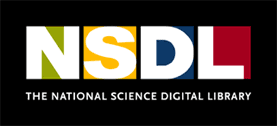About NSDL Whiteboard Report
NSDL Whiteboard Report is a free b-weekly newsletter published by NSDL Core Integration since 2000 that includes information from NSDL projects and programs nationwide. Research news, community initiatives, program highlights, and information about events of interest to a broad audience of educators, digital library projects, librarians, collaborators, and funders are featured in NSDL Whiteboard Report.
The newsletter is distributed to a growing list of subscribers via email and is also online at NSDL.org. NSDL Whiteboard Report news and resource highlights are posted on NSDL.org's homepage each week. Back issues of Whiteboard Report are available for viewing.
Sign up to have NSDL Whiteboard Report delivered to your desktop.
Contact Carol Minton Morris, NSDL Whiteboard Report editor with news and project information for Whiteboard Report.
Current Issue of NSDL Whiteboard Report
Back Issues
About NSDL Annual Reports
In 2000 the National Science Foundation selected 33 digital library projects as the premiere recipients of National Science Digital Library Program awards. Since then 235 projects in 34 states have received NSDL Program grants, in accordance with the National Commission of Mathematics and Science Teaching for the 21st Century recommendation that a dedicated Internet portal supporting mathematics and science education be established so that teachers "can have access to and contribute to an ever-expanding knowledge base about mathematics and science teaching." (The National Commission on Mathematics and Science Teaching for the 21st Century. Before It's Too Late: A Report to the Nation. U.S. Department of Education. 2000)
The NSDL story was summarized by Kaye Howe, NSDL's Executive Director, Core Integration, in remarks before a Capital Hill briefing in May, 2004: "Education has always gone out from the great libraries. We are here to tell you about how this great library, NSDL, is used in American classrooms and how important that is."
The NSDL story continues to be told in annual reports issued at NSDL's Annual Meeting each fall since 2003:
2006 Annual Report: Leveraging Collaborative Networks
Highlights the multiple roles that NSDL plays in support of STEM education, serving as resource repository, provider of services and tools, education and outreach source, locus of digital library research, and as a scaffold for collaboration - building and expanding partnerships and collaborative opportunities nationwide.- Full Version [Pages 1-19, .pdf, 1.72 MB]
2005 Annual Report: Examining NSDL's Impact
Profiles NSDL as a key piece of national educational infrastructure at work in classrooms and communities addressing the need to prepare a STEM workforce for the future.- Full Version [Pages 1-36, .pdf, 2 MB]
- Online Supersize Project Profiles Version
2004 Annual Report: Highlighting Successful Strategies for Growth
Explores applied educational achievements as leverage points for sustaining growth.- Full Version [Pages 1-28, .pdf, 1.4 MB]
Progress Report: Fall 2000-Summer 2003
Highlights historic milestones and summarizes initial growth and development of the Library.- PART 1 [Pages 1-10, .pdf, 8.2 MB]
- PART 2 [Pages 11-24, .pdf, 8 MB]
- PART 3 [Pages 25-32, .pdf, 800 KB]
About Beyond Penguins and Polar Bears
The Beyond Penguins and Polar Bears (BPPB) cyberzine aims to maximize the impact of International Polar Year research on elementary classrooms by capturing student interest and fostering the ability of K-5 teachers to integrate polar concepts into their teaching by
- selecting, augmenting, and contextualizing learning resources from the National Science Digital Library, the Ohio Resource Center, and other IPY-funded projects;
- creating 20 issues of a multimedia online magazine with a combined focus on inquiry-based science and content-rich literacy learning;
- modifying NSDL communication and production tools based on Fedora that amplify resource discovery and access to resources and increase the ease of reuse and re-purposing of content;
- disseminating deliverables through presentations, publications, and Web technologies; and
- evaluating the impact of project deliverables on teachers and students.
At the conclusion of this project the "parts and pieces" from 20 BPPB issues will be available in multiple combinations. For example, a fourth-grade teacher will be able to find everything from the BPPB collection, including images and rich media, about "Polar Bears" as he or she develops a unit about mammals.
BPPB is funded by a grant from the National Science Foundation International Polar Year (IPY) Program (DRL-0733024). An interdisciplinary team from Ohio State University (OSU), College of Education and Human Ecology; the Ohio Resource Center (ORC) for Mathematics, Science, and Reading; the Byrd Polar Research Center; COSI (Center for Science and Industry) Columbus; and the National Science Digital Library (NSDL) Core Integration team at Cornell University and University Corporation for Atmospheric Research (UCAR) are working together on this project. Content and education specialists from OSU, ORC, Byrd Polar, and COSI are creating content as well as adapting and contextualizing existing content. The NSDL Core Integration team is adapting Fedora-based tool to facilitate editorial workflow, dissemination and promotional activities. The Evaluation and Assessment Center at Miami University, Oxford, OH will conduct project evaluation.
